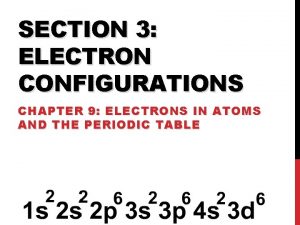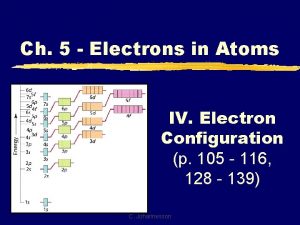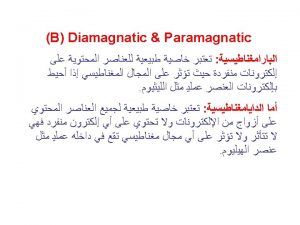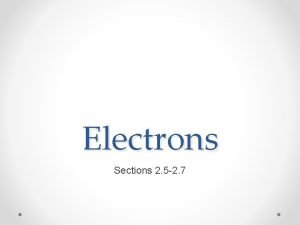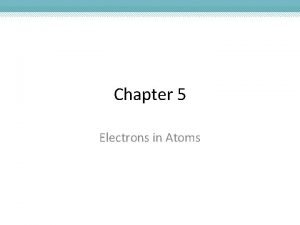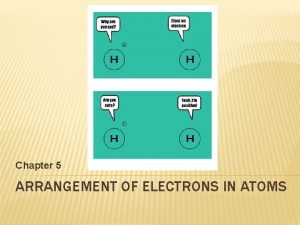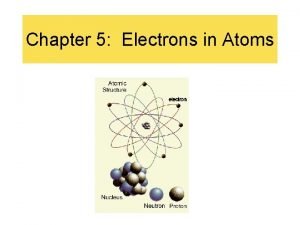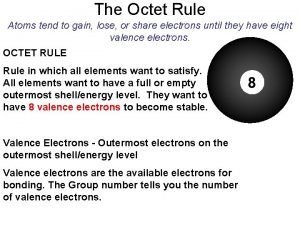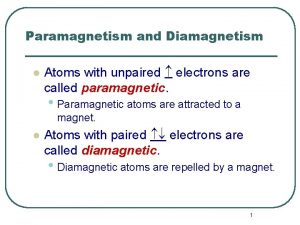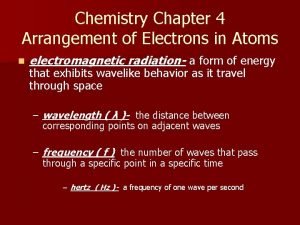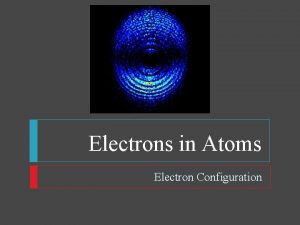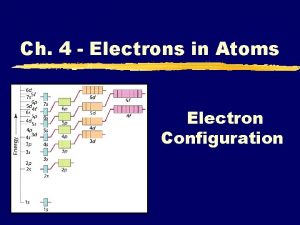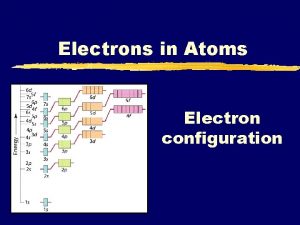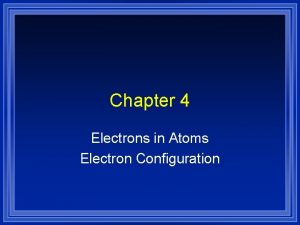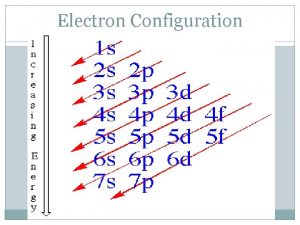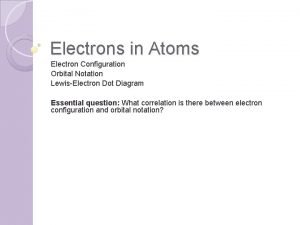Ch 4 Electrons in Atoms Electron Configuration Maximum
















![Shorthand Configuration Element symbol Electron configuration Ca [Ar] 4 s 2 V [Ar] 4 Shorthand Configuration Element symbol Electron configuration Ca [Ar] 4 s 2 V [Ar] 4](https://slidetodoc.com/presentation_image/593ed8f33992ad27cb18762b25a714d7/image-17.jpg)
- Slides: 17

Ch. 4 - Electrons in Atoms Electron Configuration

Maximum Number of Electrons In Each Sublevel Number of Orbitals Maximum Number of Electrons s 1 2 p 3 6 d 5 10 f 7 14 Le. May Jr, Beall, Robblee, Brower, Chemistry Connections to Our Changing World , 1996, page 146

Electron capacities Copyright © 2006 Pearson Benjamin Cummings. All rights reserved.

Writing Electron Configurations z. Way to show the arrangement of electrons in an atom z. Parts 1 s 2 sublevel # of electrons in that sublevel Energy level 1 s 2 2 p 4

4 f Sublevels 4 d s p s d p s n=4 f d p Energy s n=3 4 p 3 d 4 s 3 p 3 s 1 s 22 p 63 s 23 p 64 s 23 d 104 p 65 s 24 d 10… 2 p n=2 2 s n=1 1 s

Notation z. Longhand Configuration S 16 e 6 2 2 2 1 s 2 s 2 p 3 s Core Electrons Valence Electrons z. Shorthand Configuration S 16 e 4 3 p 2 4 [Ne] 3 s 3 p

Filling Rules for Electron Orbitals Aufbau Principle: Electrons are added one at a time to the lowest energy orbitals available until all the electrons of the atom have been accounted for. Pauli Exclusion Principle: An orbital can hold a maximum of two electrons. To occupy the same orbital, two electrons must spin in opposite directions. Hund’s Rule: Electrons occupy equal-energy orbitals so that a maximum number of unpaired electrons results. *Aufbau is German for “building up”

General Rules z. Aufbau Principle y. Electrons fill the lowest energy orbitals first. y“Lazy Tenant Rule”

Order in which subshells are filled with electrons 1 s 2 s 2 p 3 s 3 p 3 d 4 s 4 p 4 d 4 f 5 s 5 p 5 d 5 f 6 s 6 p 6 d 7 s 2 2 6 2 10 1 s 2 s 2 p 3 s 3 p 4 s 3 d 4 p 5 s 4 d …

Examples z. Chlorine z. Bromine z. Calcium

General Rules z. Pauli Exclusion Principle y. Each orbital can hold TWO electrons with opposite spins.

Notation z. Orbital Diagram O 8 e- 1 s 2 s 2 p

General Rules z. Hund’s Rule y. Within a sublevel, place one e- per orbital before pairing them. y“Empty Bus Seat Rule” WRONG RIGHT

THIS SLIDE IS ANIMATED IN FILLING ORDER 2. PPT H = 1 s 1 1 s He = 1 s 2 1 s Li = 1 s 2 2 s 1 1 s 2 s 2 px 2 py 2 pz Be = 1 s 2 2 s 2 C = 1 s 2 2 p 2 S = 1 s 2 2 p 43 s 23 p 4 3 s 3 px 3 py 3 pz

26 electrons. Iron has ___ Fe = 1 s 1 2 s 22 p 63 s 23 p 64 s 23 d 6 1 s 2 px 2 py 2 pz 2 s 3 s 3 px 3 py 3 pz 6 s 6 p 4 s 5 d 3 d 3 d 3 d 4 f 32 5 s e- eee- e- e- +26 e- e- ee- e- e- 4 s 4 p 3 d e- ee- e- e- 4 d 18 e- e- 5 p 18 Arbitrary Energy Scale 3 s 3 p 8 ee- 2 s 2 p 8 1 s 2 NUCLEUS 3 d 3 d

Examples z. Nitrogen z. Aluminum
![Shorthand Configuration Element symbol Electron configuration Ca Ar 4 s 2 V Ar 4 Shorthand Configuration Element symbol Electron configuration Ca [Ar] 4 s 2 V [Ar] 4](https://slidetodoc.com/presentation_image/593ed8f33992ad27cb18762b25a714d7/image-17.jpg)
Shorthand Configuration Element symbol Electron configuration Ca [Ar] 4 s 2 V [Ar] 4 s 2 3 d 3 F [He] 2 s 2 2 p 5 Ag [Kr] 5 s 2 4 d 9 I [Kr] 5 s 2 4 d 10 5 p 5 Xe [Kr] 5 s 2 4 d 10 5 p 6 Fe Sg 22 p 64 s [He] 2 s[Ar] 3 s 223 d 3 p 664 s 23 d 6 [Rn] 7 s 2 5 f 14 6 d 4
 S orbital
S orbital Electron configuration for 5 electrons
Electron configuration for 5 electrons Unpaired electrons
Unpaired electrons Br valence electrons
Br valence electrons Electron configuration vs noble gas configuration
Electron configuration vs noble gas configuration Periodic table of elements regents
Periodic table of elements regents Electrons in atoms section 1 light and quantized energy
Electrons in atoms section 1 light and quantized energy Chapter 5 arrangement of electrons
Chapter 5 arrangement of electrons Ccechs
Ccechs Atoms with 4 valence electrons
Atoms with 4 valence electrons 5 electrons in atoms
5 electrons in atoms The lowest allowable energy state of an atom
The lowest allowable energy state of an atom What is the oxidation number of lithium
What is the oxidation number of lithium Atoms with unpaired electrons are called diamagnetic.
Atoms with unpaired electrons are called diamagnetic. Electrons in atoms section 2 quantum theory and the atom
Electrons in atoms section 2 quantum theory and the atom How do chemists model the valence electrons of metal atoms?
How do chemists model the valence electrons of metal atoms? How to find the number of protons in an element
How to find the number of protons in an element Chapter 4 arrangement of electrons in atoms
Chapter 4 arrangement of electrons in atoms
